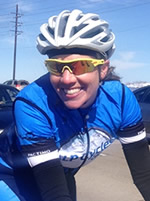By: Jennifer Sharp
Last Monday morning hit a little harder than usual. And no, it wasn't from post Super Bowl festivities. As a full-time coach and endurance cyclist, the bulk of my workouts are completed on the weekends and come Monday, I'm more than ready from a rest of day. But this Monday was different. I had some lower back pain and given my chronic trouble with my lower back, I assume I'd be okay given my daily core regimen.
Injuries come in many shapes and forms. Some are visible to the naked eye, some from over use. Regardless of how they occur one thing remains constant. REST is an important component for recovery.
Yet things persisted. That night when I taught a yoga class, I noticed a new pain when forward folding. It heightened my awareness to the sensations in my body but still, I continued with intervals on the trainer the next day and upkeep my strenuous Ashtanga yoga practice. If it doesn't hurt while you're on the bike - things shouldn't be that bad, right? On Thursday, my back had enough. It had been trying to tell me to slow down and this time it put me on bed rest lockdown.

The Erector Spinae runs parallel to the spine and is a back workhorse. Practically every move you make involves it.
Injuries are tough. Cyclists are tough too - often battling through pain while on the bike: lung-busting intervals, mountain top summits, FTP tests, pushing through when everything in your body is telling you to stop. Admittedly, cyclists/endurance athletes pain scales are skewed as a result. It's hard to know when to push through the pain and when you need to back off. Yet the body knows. The body always knows.
A visit to a chiropractor is a blessing and a curse. Turns out this is a new injury and not the chronic back pain I've dealt with in the past. I sprained my erector spinae muscle on the left side of my spine and the only way to heal is through rest. Rest, just so you know, is a four-letter word.
REST?!? You mean stick to just easy recovery rides on the bike?
Nope. Rest. Stay off the bike.
Okay. But what about x, y, or z races? What about this huge foundation of training I did? What? How? When? Why?
Encountering an injury is similar to the stages of grief: shock/denial, pain/guilt, anger & bargaining, depression/loneliness, testing, and acceptance. You may experience one or all of the stages and not necessarily in order. One thing remains constant: the more you lay off now and address this minor acute injury the sooner you may be healthy again.
And one thing is for sure, if you've been doing a sport for long enough, you're more than likely going to encounter an injury.
One thing I've found that helps navigate the emotional trauma associated with forced time off the bike is instead of focusing on what you can't do, FOCUS ON WHAT YOU CAN DO.
Here are some things you can actively do to improve recovery:
- Just as in sport, nutrition and hydration impact your ability to recover. During the initial phase of injury, inflammation occurs as the body's natural response to heal the injured area. Pain, swelling, redness and heat occur. Focus on anti-inflammatory foods such as olive oil, avocados, flax oil, oily fishes, and mixed nuts and seeds while avoiding processed foods high in saturated fats, vegetable oils and foods with trans fats. You can also include garlic, curry powder, and berries. Icing those tender areas for 15 minutes every hour can greatly reduce swelling and get you on the road to recovery.
- Once the pain and swelling has reduced, your body enters the proliferation and remodeling phases. Your metabolism can increase 15-20% from being sedentary so it's important to fuel yourself enough protein, balanced dietary fat, eating a diverse mix of fruits and vegetables and eat enough whole grain minimally processed carbs.
- Have extra downtime now that you're not doing the sport you love? It's time to sharpen those often neglected mental skills. My favorite book of all time is, "Thinking Body, Dancing Mind" by Jerry Lynch. And another favorite by Steve Peters: "The Chimp Paradox: The Mind Management Program for Confidence, Success and Happiness." Stay off social and educate yourself in the meantime!
- Get body work. Massage, acupuncture, and cupping. If you've had trouble finding the time to fit these into your schedule, now you can. Find out from other cyclists who their favorite body work person is and give it a try.
- Be diligent about your physical therapy. If you've been shown various exercises to increase your mobility - do them!
Happy healing friends. And if you have an injury healing tip you'd like to share - pease do!
ABOUT JENNIFER SHARP
 Jennifer Sharp, a USA Cycling Level 1 Coach, started racing in 2004 as a means to fulfill her competitive itch. Previously a national level boxer, she grew tired of getting hit in the head and decided to pound the pedals instead. She bought a pink Kona road bike completing several recreational rides and found herself passing as many people as possible. Since then she has multiple podiums at elite track national championships, master track national championship titles and world cup finishes under her belt.
Jennifer Sharp, a USA Cycling Level 1 Coach, started racing in 2004 as a means to fulfill her competitive itch. Previously a national level boxer, she grew tired of getting hit in the head and decided to pound the pedals instead. She bought a pink Kona road bike completing several recreational rides and found herself passing as many people as possible. Since then she has multiple podiums at elite track national championships, master track national championship titles and world cup finishes under her belt.
]]>